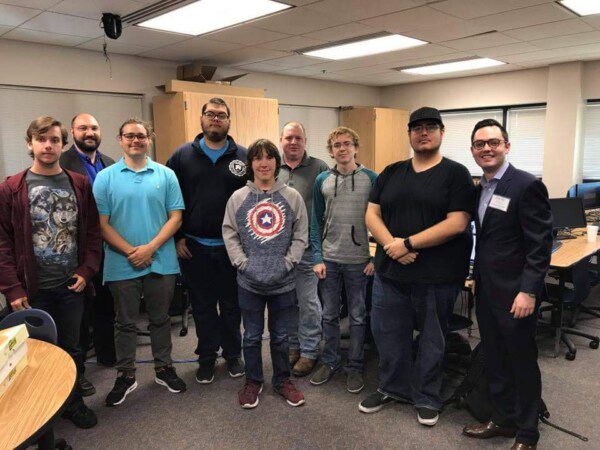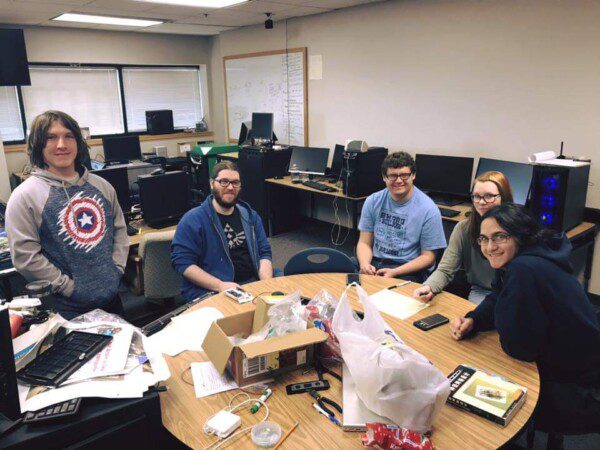SWOSU Blue Thunder Alley Accelerates Research Computing Opportunities for Students
In the fall of 2018, Southwestern Oklahoma State University became one of four schools to receive the National Science Foundation grant that connected the campus to the OneOklahoma Friction Free Network (OFFN). The Multiple Organization Regional OneOklahoma Friction Free Network (MORe-OFFN) $333,859 grant award provided $333,859 to connect four regional universities to the OFFN network, managed by OneNet.
Thanks to SWOSU’s new high-speed connection, they were able a envision a space where students could come together to practice their research computing craft. This space became Blue Thunder Alley. Initially Blue Thunder Alley was created to pay student workers to develop tutorials on research computing, but over the years it has grown exponentially.
The student-led organization known as Blue Thunder Alley now builds the computers, manages the operating systems, and even controls the firewall and network. Normally this type of research is exclusive to faculty and professional research teams, but Blue Thunder Alley allows students to gain expertise at a much younger age and refine their craft. They use a direct 10G OFFN connection that was deployed by both Chickasaw Telecom and OneNet in an area independent of SWOSU’s primary internet connection. Prior to SWOSU connecting to OFFN, the research team shared connections to the school Wi-Fi and a single data port in an office.

As Oklahoma’s regional science DMZ and dedicated research network, OFFN offers research and data support by providing higher education institutions with a dedicated network route that allows researchers to bypass slower traditional networks and transmit data at higher speeds. This dedicated connection supports a much greater position and capability for SWOSU’s students to drive and collaborate in undergraduate research opportunities. These capabilities broaden undergraduate research participation and create opportunities for more students to confidently pursue advanced degrees and further contribute to the research community.
“We’re excited to see how SWOSU has leveraged OneNet’s OFFN network for undergraduate research,” said Chancellor Glen D. Johnson. “These opportunities prepare students for educational advancement and success in future careers, and complement higher education’s role in supporting the state’s workforce and economy.”
SWOSU agrees that creating research opportunities for students leads to future job success.
“OneNet’s OFFN network connection impacted SWOSU’s research and educational initiatives by the system administration being turned over to eager students who want experiences. Because the students often graduate and get great jobs, we often get the opportunity to change directions,” said Dr. Jeremy Evert, a lead researcher at SWOSU.

Blue Thunder Alley students, Dr. Jeremy Evert, and Professor Devin Smoot meet with Jerrad Richards of Devon Energy
Blue Thunder Alley students, Dr. Jeremy Evert, and Professor Devin Smoot meet with Jerrad Richards of Devon Energy
For several years, SWOSU has been building up research computing capabilities, including a networking grant to allow for high-speed connections for their research computing equipment. In the past they have supported several student projects related to the National Science Foundation (NSF) XSEDE EMPOWER program, the Blue Waters Student Internship Program, and the Oklahoma High Performance Computing Competition.
Recently, with help from OneNet, they partnered with the Great Plains Network CyberTeam to connect SWOSU servers to the Nautilus research platform. This allows students at SWOSU to log into a server from anywhere in the world and work on their computing projects on any network connected device, like an iPad.
These are just a few of the success stories.
“One of the most rewarding stories from Blue Thunder Alley is the reaction from the Everett Dobson School of Business and Technology Advisory Board members. We brought them into Blue Thunder Alley and let our Computer Science students explain what they were researching. Our Advisory Board consists of 12 highly successful business men and women from various industries, and they were thoroughly impressed with the students and BTA’s function in their college experience,” said Patsy Parker, Professor and Associate Dean and Department Chair of Computer Science.
Initially funding for Blue Thunder Alley came through the Office of Sponsored Programs, which received its funding from the university. This was intended to help faculty initiate research projects. Since then, students have received funding through the NSF XSEDE Blue Waters Student Internship Program, the XSEDE EMPOWER Program, and the NSF Research Experience for Undergraduates.

Students work on projects during Winter Camp, a time for them to bring their ideas and skills to Blue Thunder Alley
Students work on projects during Winter Camp, a time for them to bring their ideas and skills to Blue Thunder Alley
One of Dr. Evert’s favorite student projects is an upcoming grant proposal. “Two students are helping write a National Science Foundation Campus Cyber Infrastructure grant. SWOSU student Arianna Martin will help us turn the grant in just before she goes to the International Conference for High Performance Computing, Networking, Storage, and Analysis (SC21) as a student volunteer,” he said.
Another student success story is Devin Smoot, who helped create Blue Thunder Alley.
BTA’s student success stories drive OneNet’s goal to continue expanding the OFFN network to colleges and universities across the state.
“OneNet’s mission is to support research and education initiatives at Oklahoma’s higher education institutions. SWOSU’s Blue Thunder Alley is a prime example of how access to research computing can grow students into successful professionals in STEM careers,” said Brian Burkhart, OneNet’s senior director of network systems.
The Blue Thunder Alley idea grew out of a need for a place for students to work together. BTA continues to provide students with opportunities, like the chance to work with OneNet to connect to the OFFN network. Initially it started as a vision of students working together, but over the years it has developed into a cutting-edge student-led organization that allows students to gain advanced research experience, working hands on to manage their network and firewalls, and pushing the boundaries of new research initiatives.
